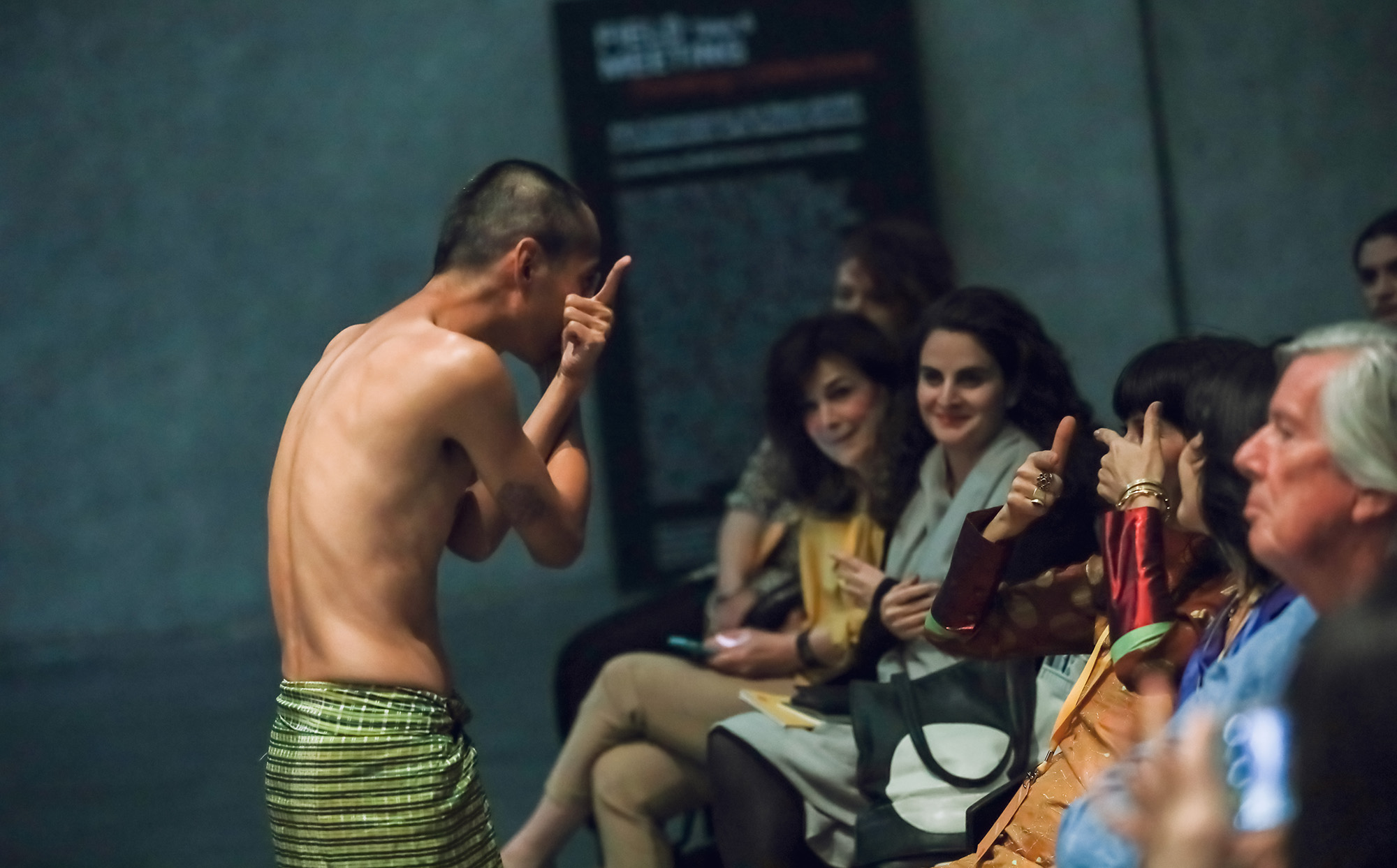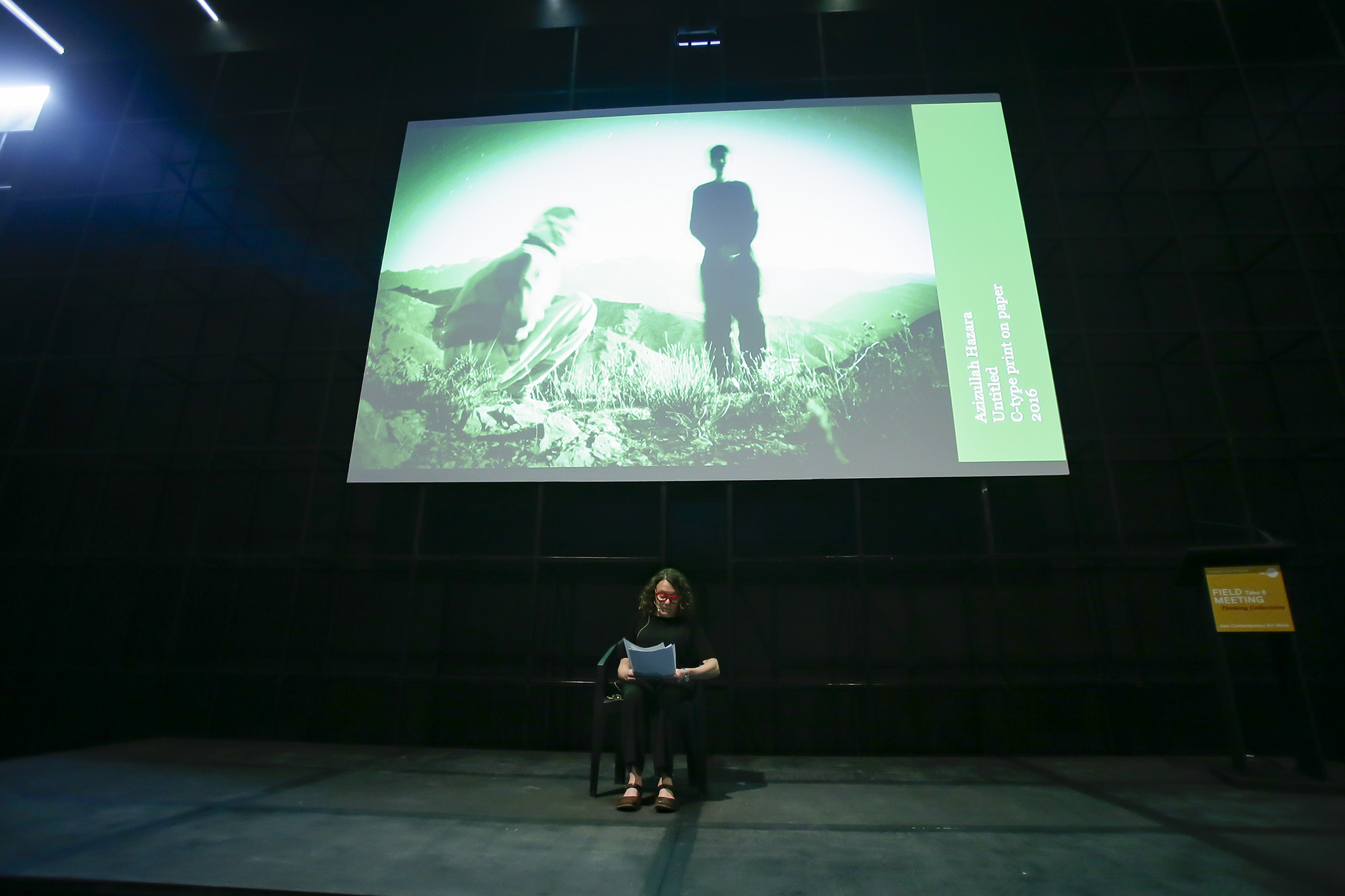Creative Alchemy: ACAW’s Field Meeting Take 6
By Chloe Chu

MOE SATT,

To kick off Asia Contemporary Art Week’s two-day forum, “Field Meeting Take 6: Thinking Collections,” curator and writer Leeza Ahmady performed a reading of On Kings, Films and Astronomads: A Script from Cave Paintings / Sufi Fluxus Production (2017). The fictional story begins with a king reflecting on his life to an audience of transcended beings, who evaluate his readiness for the astral plane, where all energetic bodies—comprised of abstract thoughts and emotions—merge. After deliberating, the judges decide to grant the king entry to the dimension of oneness. This realm served as a backdrop for the ensuing events of “Thinking Collections,” which prompted presenters and audience members to reflect on their own perspectives and uncover the intersections between each others’ ideas—ultimately transforming their inner-worlds and outlooks.

Throughout the weekend, Ahmady reminded those in attendance that such creative alchemy requires engaging from a heart space. This approach also lends itself to upending the reductive methods that we routinely use to understand our surroundings, including logic, and makes room for encounters with universal truths. Each year, Field Meeting’s performances, talks and exhibitions deconstruct the conditioned understandings of one word “as a way for artists and arts professionals to think more consciously about their work and community.” At the sixth iteration of the event, set in Dubai’s Alserkal Avenue complex—a first for the New York-born series—attentions were directed toward the term “collection” and its possible disassociation from the global art market.
The morning session of the first day, “Inside Out: The Artist as Collector,” dealt with how every individual owns and is shaped by immaterial collections: of memories, experiences, beliefs, sensations and thoughts. Ranbir Kaleka spoke about the non-events of his childhood memories. These recollections informed Kaleka’s phantasmagorical intermedia works, of slow-moving video projections on paintings, which toy with the artifices of cinematic time and the painterly surface. Unpacking his installation Cul-de-sac in Taxila (2010), which comprises a painting of a seated man overlaid with moving imagery of a white horse that appears briefly, Kaleka added, “A horse is never a horse, but an idea.” This notion was echoed in Heman Chong’s closing statement for his presentation about his extensive photographic series “Foreign Affairs” (2018– ), capturing the nondescript backdoors of different embassies. Chong invoked conceptualist Redza Piyadasa’s inscription on his 1977 sculpture: “A fact has no appearance.” The quote encapsulates Chong’s interest in the invisible, which led to his dissection of the collective negotiations on ideologies, legality and nationhood that define society’s underlying mechanisms. Rounding out the session, Nikhil Chopra donned a sequined green dress and teasingly beckoned audiences to follow him to an empty warehouse, where he proceeded to smudge lipsticks onto the white walls. The resulting drawing of an expansive sea, flanked by two craggy cliffs, conveyed his struggles in his teenage years with locating “home.” Chopra’s statement, “I am my own mini museum, my body is a container of all my interactions, experiences [and] memories,” succinctly represented the spirit of the first panel.

“Pendulum Swings and Spheres of Influence” developed a question that Chong had touched on: How do national narratives impact the consciousness of a country’s inhabitants? Umber Majeed’s animation and lecture-performance Atomi Daamaki Wali Mohabbat (The Atomically Explosive Love) (2017– ) seeks to trace how love, religion, nature and science are subsumed under the state and then reproduced and scattered. Majeed homes in on the color green as a common thread in the dissemination of Pakistani nationalist ideals. Green enters bodies not just through the eyes, as with the Pakistani flag, but also mouths, in the form of the glorified flora of the lands. The embodiment and performativity of nationalism were foregrounded in the subsequent presentations. Bassem Saad and Edwin Nasr explored the aesthetic violence rendered by virtual reality games restaging conflicts in the Middle East. These simulations are used in the United States as part of post-traumatic stress disorder therapy, whereas Hezbollah utilizes similar programs to prime its soldiers with a sense of martyrdom, future-proofing the traumas they will endure by giving them an ideological basis for their suffering. Khadim Ali then meandered through his personal history, discussing the demons that his great-grandfather told of as a singer, the demonization of Hazaras, and the othering of immigrants in Australia. Alexis Destoop screened his video, Phantom Sun (2018), depicting abandoned factories amid snowy hills—landscapes carrying the scars left by the rapacious Soviet regime. Moe Satt’s less somber performance capped the panel. He traversed the room, stopping in front of individual participants while contorting his fingers around his face, which audiences somehow intuited to mean “please mirror me”—a reminder that it is possible to find a constructive, if playful, basis for intersecting subjectivities.
The evening session of day one, “Modes of Being: Ideologies and Space as Malleable Entities,” picked up on how our collections of ideas are embedded in the ways that we live. Sam Samiee delved into Adab, a Persian code of conduct that aims to ensure harmony within people and between neighbors. Burçak Bingöl shared how she deepened her understanding of Turkey’s complex culture by studying the Topkapi Palace’s porcelain tiles, which bear motifs culled from different civilizations along the Silk Road. Zheng Chongbin outlined the concepts behind his immersive ink-based installations. By bending space and light, Zheng underscores how our entire bodies perceive and inform our positions in the world. Zheng’s interest in charging spaces with life and phenomenological possibilities resonated with the concerns of Arakawa and Madeline Gins, whose practice was demystified by ST Luk. Using Arakawa and Gins’ 1992 Study for a Baseball Field for the Architectural Body—a proposal detailing a dramatically uneven playing field with dips and rolling mounds—and excerpts from the documentary Children Who Won’t Die (2010), Luk brought home the duo’s belief that architecture’s purpose is not to provide comfort and safety, but to keep us truly alive and fully present. Arahmaiani, the last presenter, stepped up to the podium with her own spoken code, or Adab, for artists.

FRANCESCA RECCHIA, Afghanistan Untitled,
By the second day, I knew that the Field Meeting's magic had infiltrated me, because I felt Francesca Recchia’s ruminations about what she has seen in war-torn Kabul with my whole heart. In her account, Recchia wrestled with how she was unable to articulate the complexities of her encounter with deportees on a flight to Kabul, and how, in her view, this made her complicit in the horrors of war. She powered through, affirming that: “The choice of humanity is by definition shared. I write to not feel alone—to know that I am not alone.” “Community as Institution and Institution as Community” continued with M+ digital content manager Lara Day, who discussed her endeavors to pluck “materials from brains and share them with the world” in emotionally and physically engaging ways. Moe Satt’s performances, including one where he invited the audience to flick rubber bands at each other, accomplished just that. Though implicitly recalling the civil war in his native Myanmar, the activity immediately roused giggles, with a stranger next to me telling me that it reminded them of a school bus ride.
How we engage with each others’ collections was the focus of “A Loose Canon: Who is Collecting and Why?” Tasked with running a Master of Arts program for New York’s Fashion Institute of Technology in Dubai, and troubled by the precedence of colonial education models in the Middle East, Natasha Degen and Sandra Skurvida solicited feedback for how they could better enmesh their course with the local specificities of Dubai and take into account the multiple voices involved. M+ Sigg senior curator Pi Li complicated the question of who defines canons and how. His positioning is that an institution’s collection, specifically that of M+, should offer an authoritative narrative while, perhaps paradoxically, preserving art’s ability to confront and provoke debate, harking back to Arakawa and Gins’ proposition that art should pose a threat to complacency. In her “lecture-nonperformance,” Wong Kit Yi karaoke-d her way through how she has established not just artist-client relationships with her collectors, but has probed models such as 99-year leases, which will be seen through by her and her patrons’ offspring. Wong ended by asking the audience what we thought our terms of engagement were with her—had we been ensnared in an instance of “nonperformance”? Returning to Degan and Skurvida’s considerations of intercultural relations, River Lin’s mashup of choreographies, 20 Minutes for the 20th Century, but Asian (2016), performed by dancer Wen-chung Lin, was an investigation of how Asia-Pacific dance styles reflect the colonial and intertwined histories of the region.
Between the talks and performances of the second day were discussions by the artists and curators who presented works in the event’s two pop-up exhibitions—a rich collection of materials that would easily fill out another article. As I looked around me while Arahmaiani was smashing plates as part of her cathartic performance Breaking Words (2006), which closed the thought-marathon that was “Field Meeting Take 6,” I clocked the patches of indigo ink that were beginning to sink into people’s skin. Earlier in the day, we had been invited to stamp our fists on Moe Satt’s body. The mutual impact would last a while.
Chloe Chu is ArtAsiaPacific’s associate editor.
Asia Contemporary Art Week’s “Field Meeting Take 6: Thinking Collections” took place at Alserkal Avenue, Dubai, on January 25–26, 2019.
To read more of ArtAsiaPacific’s articles, visit our Digital Library.









